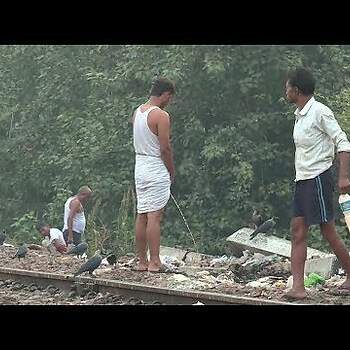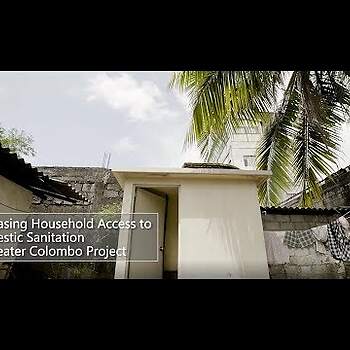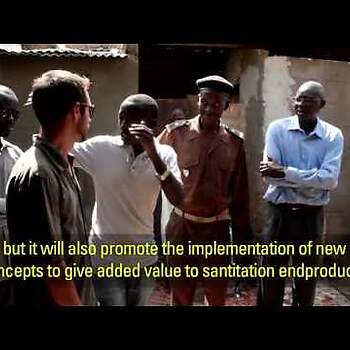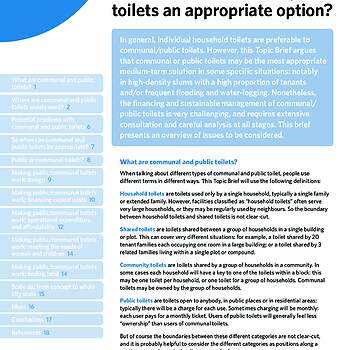Onsite sanitation
For the past 100 years, sewer systems followed by treatment have been safely and effectively removing excreta from most industrialized cities, greatly contributing to the quality of life in cities. However, they are resource and cost intensive.
These systems tend to be financially unattainable for many countries. Onsite, decentralized options, or combined systems are a better and more sustainable solution. Sewerage may be applied in high-density commercial and industrial zones, and onsite sanitation in less dense residential zones.
One third of the world’s population is served by onsite sanitation technologies.
Onsite sanitation systems have their own challenges and limitations. Pit latrines have limited value if women cannot use them safely 24 hours a day or children are frightened to use it (because it is dark or because they are frightened of falling into the pit). Well maintained communal or public toilets have limited value if they are not open all the time or if they charge too much for low-income groups to afford to use them. Flush toilets don’t work if water supplies to flush them are intermittent. Ecological sanitation will not return nutrients to the soil unless it is easy, convenient and cheap to get ‘the nutrients’ to crop-growers that want them.
Any improvement in sanitation has to compete successfully with ‘unimproved sanitation’ which is very cheap. Defecating in the open or into a plastic bag or wastepaper (“wrap and throw”) may seem very inappropriate forms of sanitation – but they are free of monetary cost and often involve little extra time. For most people, ‘wrap and throw’ can also be done within the privacy of the home, 24 hours a day. Sanitation provision must also meet everyone’s needs, if open defecation or ‘wrap and throw’ and their contamination of the environment (and of food, water, clothes and hands) are to be avoided.
While ‘good sanitation’ has the same basic attributes – different contexts influence whether a particular form of ‘sanitation’ works. Pit latrines built next to homes may work very well in many rural contexts but cannot work in many urban contexts where there is no ‘room’ for them. Communal sanitation may work very well in some contexts and very badly in others – relating to, for instance, the quality of management, the provision for washing, how charging and queuing are managed, and whether women and children feel safe using it (especially at night). The ‘best’ sanitation model is so influenced by: population concentration and population density; site characteristics; the resources available to individuals and households; and the capacity of local government to contribute something useful.
Fecal sludge management (FSM) is the collection, transport, and treatment of fecal sludge from pit latrines, septic tanks or other onsite sanitation systems. Fecal sludge is a mixture of human excreta, water and solid wastes that are disposed of in pits, tanks or vaults of onsite sanitation systems. The fecal sludge service chain includes onsite containment of fecal sludge, followed by some form of emptying/removal, transportation, treatment, and final end use or safe disposal.
FSM is necessary in densely populated areas where a proportion of the population is not connected to a sewerage network, and the covering and rebuilding of pit latrines is not possible. This is the case in many urban areas in developing countries, but such services are also used in developed countries where sewerage systems are unavailable. FSM services are usually provided by formal and informal private sector services providers, local governments, water authorities and utilities. However, in many developing countries FSM services are often unavailable, or if they are available are often informal, unregulated, unhygienic and unsafe. This can lead to surface water and groundwater pollution, the spreading of pathogens into the environment and adverse public health impacts. It can also result in unreliable services with relatively high costs to the households which need them.
The entire service chain needs adequate management to ensure protection of public and environmental health. However, in the majority of low-income countries, adequate Fecal Sludge Management is not properly in place or managed.
Onsite sanitation technologies can provide adequate access to sanitation if the entire treatment chain is managed properly, can be five times less expensive than sewer systems, and the two solutions can operate in parallel to provide access to entire cities.
Relevant links are provided below.
https://www.wsup.com/insights/when-are-communal-or-public-toilets-an-appropriate-option/



